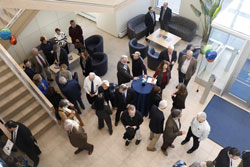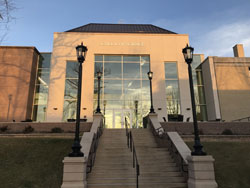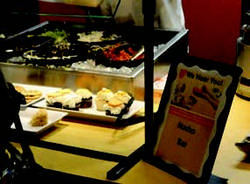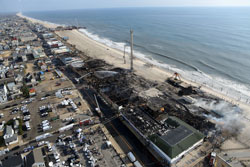The University celebrated the completion of the $40 million Thomas A. Edison Science Hall construction with a ribbon-cutting ceremony and reception on Tuesday, Feb. 13.
The event consisted of student-led tours of the building followed by speeches given by prominent figures from the campus and the surrounding area involved in the renovation process, including: Dean of the School of Science Steven Bachrach, Ph.D.; University President Grey Dimenna, Esq.; State Senator Vin Gopal; Assemblyman Eric Houghtaling; Assemblywoman Joann Downey; and Mayor of West Long Branch Janet Tucci.
Featured speakers for the event included a freshman biology student Jesse Bragger, who gave remarks about what the new renovations mean for students in her cohort.
Bragger spoke about how the new lab facilities and study accommodations make learning easier for her and her fellow students and were crucial to her decision to attend the University.
All of the renovation and additions to the building took about a year and a half to complete according to Bachrach. The building now boasts new teaching and research laboratories, classrooms, study areas, and an atrium with an accompanying multipurpose room.
“The event was really [held] just to thank everybody who had been involved in that project, the people that initiated the idea, the Board of Trustees who supported it through paying for it, [and] some donors that provided funding for parts of the building,” said Bachrach. He also noted that representatives from the State Assembly and State Senate were present and were recognized for their support in getting the State of New Jersey to contribute $5 million to help complete the project.
 “This event was a wonderful way to let Monmouth’s sponsors physically see for themselves how students are already benefitting from their generous support,” said Nicole Sivetz, a junior biology and chemistry student, who led tours of Edison Hall as part of the School of Science Peer Mentor program. “In my opinion, the ceremony was a success and I look forward to seeing how a revitalized Edison will continue to make Monmouth shine.”
“This event was a wonderful way to let Monmouth’s sponsors physically see for themselves how students are already benefitting from their generous support,” said Nicole Sivetz, a junior biology and chemistry student, who led tours of Edison Hall as part of the School of Science Peer Mentor program. “In my opinion, the ceremony was a success and I look forward to seeing how a revitalized Edison will continue to make Monmouth shine.”
Bachrach pointed out some notable features of the building post-construction. The new vivarium will allow for maintaining animal colonies over several generations for research purposes in a humane environment. Student gathering spaces range from open areas to quieter private areas for meeting and studying, which are conducive to collaboration that makes Edison a “second home” for students.
Bachrach was also enthusiastic about the new organic chemistry labs that will allow for increased hands-on participation in experiments for students as well as instructor oversight for safety.
Associate Dean of the School of Science Catherine Duckett, Ph.D. pointed to the use of windows and natural light as ways of making the area more welcoming and better for collaboration. She also raised a concern that the large windows may not be the best design for migratory birds, which can collide with the glass and die.
“The open and bright feel of Edison’s new design is definitely my favorite part about the remodeling,” said Sivetz. “My old lab was a small, cinderblock space with only a tiny window to see outside. Now we have a modern, spacious place that is both exciting to new students interested in science and conducive for professors and their groups to pursue more intense research endeavors.”
“All the tenure and tenure-track faculty now have a brand-new lab that was built out to their specifications if they had been here prior to the construction,” Bachrach said.
Each 1,500 square foot room is shared between two faculty members and are outfitted with state-of-the-art equipment, which will remove some past logistical limitations on research. He also explained that the School of Science plans on hiring more professors over the next few years and having the lab facilities makes the University much more appealing.
“I am beyond grateful to study in such a beautiful new building,” Bragger said in her speech. “Being in this modern and up-to-date environment allows students to fully thrive and enhances our ability for success.”
Duckett explained that construction implemented aspects of student feedback, through the Peer Mentor program, which contributed to increased spaces for discussion and studying.
Bachrach also looked toward the future of the School of Science, explaining the advancements that will further enhance the quality of the programs offered. The department acquired a 49-foot research vessel to give students hands-on experiences through the marine and environmental biology program. In addition, a field research station is in the works in Rumson, where programs are being prepared for outreach to local school districts. New faculty hires will bring new ideas and research to the University.
“A large part of science, which can often go unnoticed, is that fact that this field is in part a business. It is critical for scientists to be able to communicate the importance of their work to others in order to continue doing the great things they do,” Sivetz explained. “Without the support of their community, scientists cannot hope to create the positive impact they aspire to make.”
PHOTO TAKEN by Courtney Buell
PHOTO TAKEN by Matthew Aquino




